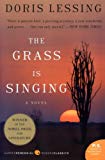
The novel begins with a newspaper clipping about the death of Mary Turner, a white woman, killed off by her black servant Moses for money. The news actually acts like an omen for other white people living in that African setting. After looking at the article, people behave as if the murder was very much expected. The bulk of the novel is a flashback of Mary Turner's life up to her murder at the hand of Moses in the last chapter.
Mary has a content life as a single white Rhodesian (we assume, though the novel refers to both Rhodesia and the Union of South Africa simply as South Africa, while making clear the farm is in Southern Rhodesia) woman. She has a fine job, numerous friends, and values her independence. Nevertheless, after overhearing an insulting remark at a party about her spinsterhood, she resolves to marry.
The man she marries, after a brief courtship, Dick Turner, is a white farmer struggling to make his farm profitable. She moves with him to his farm and supports the house, while Dick manages the labour of the farm. Dick and Mary are somewhat cold and distant from each other but are committed to their marriage. Dick and Mary live together an apolitical life mired in poverty. When Dick gets sick Mary takes over the management of the farm and rages at the incompetence of her husband's farm practice. To Mary, the farm exists only to make money, while Dick goes about farming in a more idealistic way.
Mary and Dick live a solitary life together. Because of their poverty Dick refuses to give Mary a child. They do not attend social events, yet are a great topic of interest among their neighbours. Mary feels an intimate connection with the nature around her, though being in general rather unexplorative in nature.
Mary is overtly racist, believing that whites should be masters over the native blacks. Dick and Mary both often complain about the lack of work ethic among the natives that work on their farm. While Dick is rarely cruel to the workers that work for them, Mary is quite cruel. She treats herself as their master and superior. She shows contempt for the natives and finds them disgusting and animal-like. Mary is cross, queenly, and overtly hostile to the many house servants she has over the years. When Mary oversees the farm labour she is much more repressive than Dick had ever been. She lets them work harder, reduces their break time, and arbitrarily takes money from their pay. Her hatred of natives results in her whipping the face of a worker because he speaks to her in English, telling her he stopped work for a drink of water.
This worker, named Moses, comes to be a very important person in Mary's life when he is taken to be a servant for the house. Mary does not fear her servant Moses but rather reserves a great deal of disgust, repugnance, and avoidance for him. Often Mary does all she can to avoid having any social proximity with him.
After many years living on the farm together, Dick and Mary are seen to be in a condition of deterioration. Mary often goes through spells of depression. In her frailty, Mary ends up relying more and more on Moses. As Mary becomes weaker, she finds herself feeling endearment towards Moses.
On a rare visit from their neighbour, Slatter, Mary is seen being carelessly and thoughtlessly kind to Moses. This enrages Slatter. Slatter demands that Mary is not allowed to live with that worker as a house servant. Slatter sees himself as defending the values and integrity of the white community.
Slatter uses his charisma and influence to convince Dick to give up ownership of his farm and go on a vacation with his wife. This vacation is to be a sort of convalescence for them. Dick spends his last month on his farm with Tony, who has been hired by Slatter to take over the running of the farm. Tony has good intentions and is very superficially cultured, but he finds himself having to adapt to the racism of the white community. One day Tony sees Moses dressing Mary and is surprised and somewhat amazed by Mary's breaking of the 'colour bar'.
The book closes with Mary's death at the hand of Moses. Mary is expecting his arrival and is aware of her imminent death. Moses does not run from the scene as he originally intends but waits a short distance away for the arrival of the police.
Already have an account? Log In Now